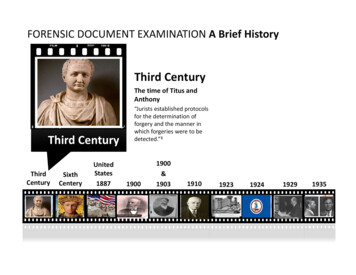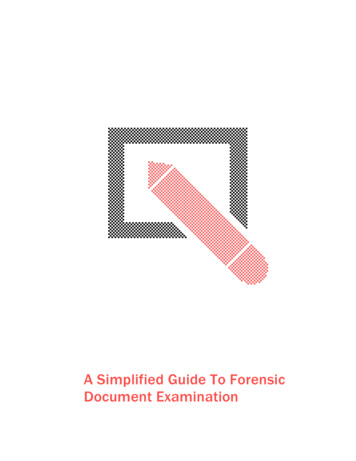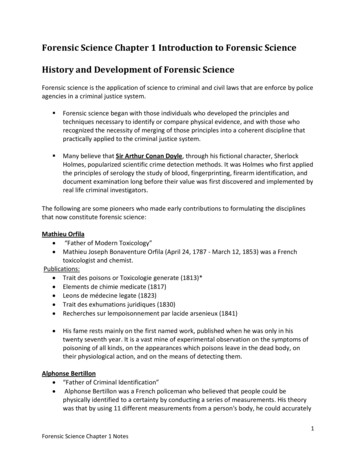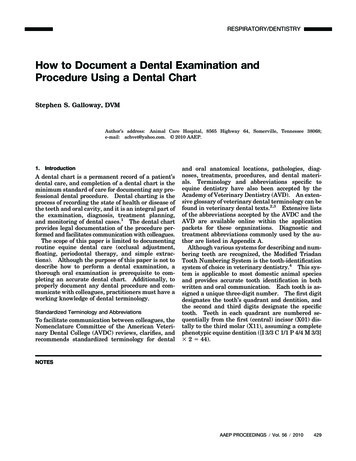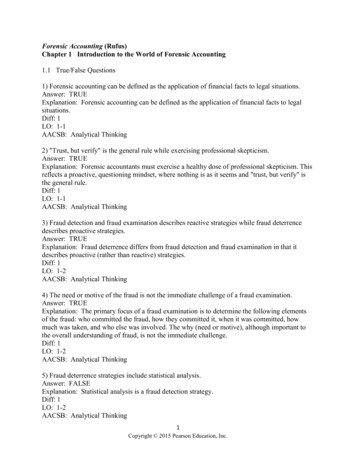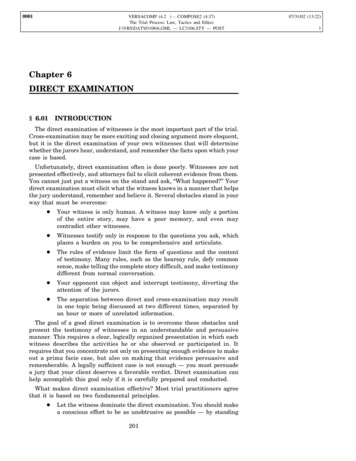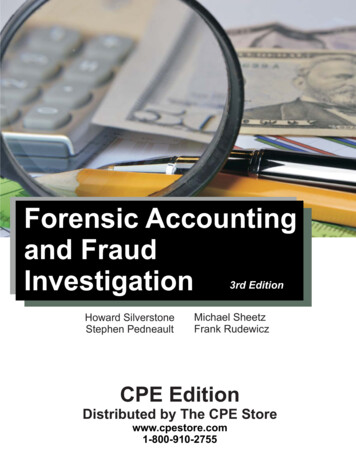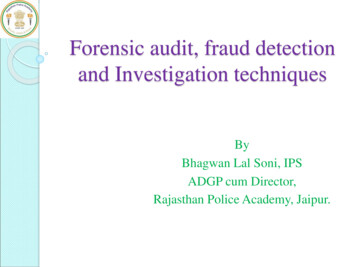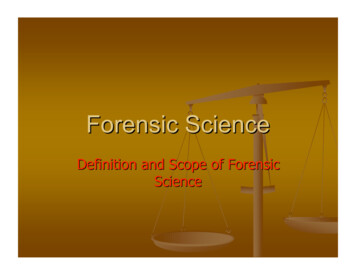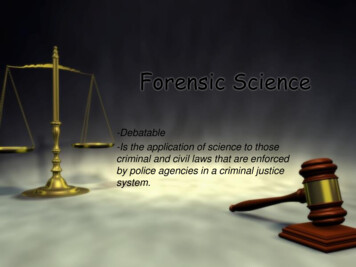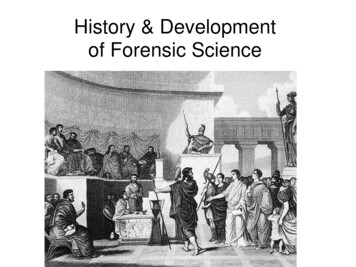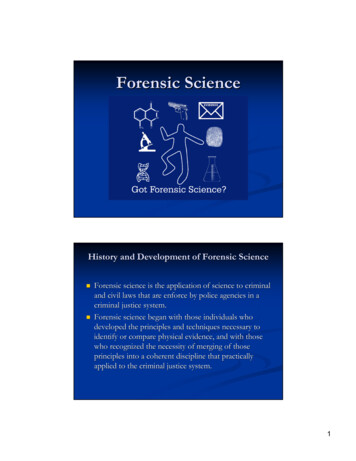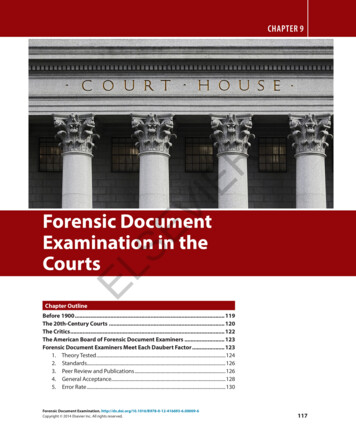
Transcription
VIERCHAPTER 9ELSEForensic DocumentExamination in theCourtsChapter OutlineBefore 1900.119The 20th-Century Courts.120The Critics.122The American Board of Forensic Document Examiners.123Forensic Document Examiners Meet Each Daubert Factor.1231. Theory Tested.1242. Standards.1263. Peer Review and Publications.1264. General Acceptance.1285. Error Rate.130Forensic Document Examination. -6Copyright 2014 Elsevier Inc. All rights reserved.117
Forensic Document ExaminationELSEVIEREarly Court Challenges.13121st-Century Courts.132Conclusion.143118
Forensic Document Examination in the CourtsFairness is what justice really is.(Potter Stewart, Time, October 20, 1958)Before 1900FVIERorgery evolved along with the development of handwriting. Testimony for forensic document examinersbegan in the English-speaking courts with the caseof Goodtitle d. Revett v. Braham in 1792 (Huber andHeadrick, 1999). Two experts qualified to testify based ontheir experience as inspectors of franks (ibid). Expert testimony in questioned documents was admitted inMassachusetts in 1836 in the case Moody v. Rowell (ibid).ELSEEarly questioned document cases in the United Stateswere hampered by limiting known writings in a caseto only those already in evidence following the English common law practice. Court decisions inMassachusetts in 1814, followed later by Connecticutand Vermont, allowed the submission of other knownwriting samples (Hilton, 1979). This expansion ofknown writings available for submission in a caseimproved the quality of handwriting comparisons.In the late 1800s, forensic document examinationwas expanded to include testimony on inks andt ypewriting (Levinson, 2001). Books published byearly forensic document examiners included:A Treatise on Disputed Handwriting (1894) by WilliamElijah Hagan, Manual for the Study of Documents(1894) by Persifor Frazer, and Ames on Forgery (1899,1901) by Daniel T. Ames (Riordan et al., 2013).119
Forensic Document ExaminationThe 20th-Century CourtsVIERAlbert S. Osborn, with his book Questioned Documentsin 1910, is considered the father of questionedd ocuments (Osborn, 1910). He expanded the workbeyond handwriting to include paper examinations,and ink and typewriter examinations (Huber andHeadrick, 1999). Osborn’s pioneering work in forensicdocument examination through his testimonies,lectures, and books helped broaden the use of forensic document examination in the courts. For moreabout Albert S. Osborn see Chapter 2.ELSEUnited States courts have relied on forensic document examiner (FDE) testimony for more thana century. In 1913, a U.S. statute allowed known writings to be admitted in court for comparison withquestioned writing (Vargas, 2008). The Frye rule,based on the Frye v. U.S., 293 F1013 (D.C. Cir. 1923)case, required that expert testimony must havegained general acceptance in the particular disciplinein order to be admitted (ibid).In 1975, the Federal Rules of Evidence gave courtsbroader power to decide on expert witness admissibility (ibid). The Frye and Federal Rules of Evidencewere in place until 1993. The United States SupremeCourt ruled in Daubert v. Merrell Dow Pharmaceuticals,509 U.S. 579 (1993), that additional factors may beconsidered for the admission of scientific evidence.The Frye standard of general acceptance was incorporated as one of the flexible Daubert factors.120
Forensic Document Examination in the CourtsThe Daubert factors set out to determine the reliability of scientific evidence by asking:1. whether the theory could be tested,2. whether there were standards,VIER3. whether there were publications in peer-reviewedliterature,4. whether there was general acceptance in theparticular discipline, and5. whether a known error rate could be developed.ELSEThe Daubert decision sought to expand the admissionof novel scientific evidence. It was not intended toapply to well-established forensic science disciplineslike forensic document examination. Forensic document examination was not new; FDE testimonyhas been part of solid case preparation in the UnitedStates courts for more than 100 years. It was also notnovel; the Questioned Document Section was one ofthe founding sections of the American Academy ofForensic Sciences in 1948.Following the Daubert decision, the judge ruled inU.S. v. Starzecpyzel, 880 F. Suppl. 1027 (S.D.N.Y., 1995)that Daubert did not apply to forensic documentexamination because it did not meet the Daubertcriteria, but was still admissible as a technical skill. Thiscase caused FDEs to carefully review empirical studies121
Forensic Document Examinationin the field and to begin publishing more research toprove the individuality of handwriting. Courts hadnever before required FDEs to prove through empirical studies that handwriting was individual or thatFDEs are more proficient in identifying handwritingthan the layman. Those days of general acceptancewere gone and a golden age of research for FDEs wasinitiated.SEVIERFollowing Daubert, in General Electric v. Joiner, 78 F.3d524 (1997), a judge was given greater leeway to rejectopinion testimony, and in Kumho Tire v. Carmichael,526 U.S. 137, 119 S. Ct. 1167, 143 L.Ed.2d 238 (1999),the Daubert factors were extended to include scientific as well as technical or other specializedexpert opinion testimony (Riordan et al., 2013).The CriticsELIn 1989 a law review article titled Exorcism of I gnoranceas a Proxy for Rational Knowledge: The L essons of Handwriting Identification Expertise (Risinger et al., 1989)attacked forensic document examination and compared FDE to witchcraft. Forensic documentexaminers dismissed the article completely because itwas filled with inaccuracies, was not a peer-reviewedpublication, and the three authors were not trained inforensic document examination. The arguments thatthe authors made against FDEs resurfaced after theDaubert decision. In fact, the authors made a cottageindustry out of opposing FDEs in court as expertcritics. Responses to the critics appear in research on122
Forensic Document Examination in the Courtsthe admissibility of handwriting evidence in court oenssenspublished by Vastrick (Vastrik, 2004) and by Min his law review article Handwriting IdentificationEvidence in the Post-Daubert World (Moenssens, 1997).The American Board of ForensicDocument ExaminersSEVIERChallenges to FDEs in court were met by the American Board of Forensic Document Examiners(ABFDE). The Daubert Group consisting of three FDEswas formed within ABFDE to help track Dauberthearings involving FDEs around the country, and toprovide a concise guide to show how FDEs meet eachof the Daubert factors for the admission of scientificopinion testimony (Riordan et al., 2013). The DaubertGroup has assisted FDEs successfully in more than 30Daubert hearings (ibid).ELForensic Document Examiners MeetEach Daubert FactorThe basic theory in forensic document examinationregarding handwriting is that no two people writeexactly alike. The individuality of handwriting hasbeen successfully proven through consideration ofthe five Daubert factors. The following material, whichexplains how forensic handwriting identificationmeets each Daubert factor, is based on a PowerPointpresentation developed by Kirsten Singer and JanSeaman Kelly (Singer and Kelly, 2012).123
Forensic Document Examination1. Theory TestedVIERThe individuality of handwriting has been validatedthrough computer-based research programs including: CEDARFOX, developed by Dr. Sargur Srihariet al. at the State University of New York, Buffalo;FLASH ID, developed by Gannon Technologies Groupin Alexandria, Virginia; and FISH, developed by theBKA in Germany and the U.S. Secret Service.SEIn an article titled “Individuality of Handwriting” in theJournal of Forensic Sciences, Dr. Sargur N. Srihari presented research that found that based on theconsideration of only eight characteristics, the computer system identified each of the 1,500 writers inthe study with a 98% confidence level. When considering more than eight characteristics, the researchsuggested that the confidence level would approach100% (Srihari, 2002).ELFLASH ID (Forensic Language-Independent AnalysisSystem for Handwriting Identification) is a softwareprogram that uses handwriting to identify writers.Handwriting is scanned into a database, and b iometriccontent is extracted and saved as image files. FLASHID converts images of handwriting into graphemes.Graphemes may consist of portions of letters, wholeletters, or groups of letters. Graphemes are classifiedby their topology and geometric features. Statisticalanalysis of the topology and geometric features of thegraphemes helps to distinguish one writer fromanother. A profile is established for each124
Forensic Document Examination in the Courtshandwriting sample and compared to other profiles inthe FLASH ID Database Builder (Walch and Gantz,2013). FLASH ID is not in general use to date outsideof a few large government laboratories.VIERFISH (Forensic Information System for Handwriting) isa database used by large government laboratories inthe United States and Germany. FISH is based on theindividuality of handwriting. In the United StatesSecret Service laboratory database and internationaldatabases, out of more than 110,000 writers, no twohave demonstrated exactly the same handwritingcharacteristics (Dusak, 1993; Singer and Kelly, 2012).ELSETwins write more similarly than non-twins, but theirhandwritings can be discriminated by FDEs and computer examination programs, further supporting thetheory of the individuality of handwriting. The studyOn the Discriminability of the Handwriting of Twins(Srihari et al., 2008) found that in comparing verification samples of non-twins and pairs of twins, there wasan 87% correct verification rate result for twins, and a96% correct verification rate for non-twins. Laypersonsperformed poorer than the c omputer, but forensicdocument examiners outperformed the computer.Other twins handwriting research that supports thetheory of the individuality of handwriting includes: AnInvestigation into the Degree of Similarity in the Handwriting of Identical and Fraternal Twins in New Zealand(Boot, 1998), The Handwriting of Identical Twins( Gamble, 1980), and A Statistical Study of Handwritings125
Forensic Document Examinationby Twins and Other Persons of Multiple Births (Beacom,1960).SEVIERAdditional general research that supports the theoryof the individuality of handwriting includes: TheDetermination of Authorship from a Homogenous Groupof Writers (Durina and Caligiuri, 2009), Lineup: TheReliability of Examinations Involving Multiple W riters ccurrence of(Parrett and Szabo, 2003), A Study of the OCertain Characteristics in a Random Population (Horton,1996), Case Report: The I ndividuality of HandwritingDemonstrated Through the Field Screening of 1000Writers (Shiver, 1996), A Review of Handwriting SearchCases as an Indicator of the Individuality of Handwriting niqueness of Writing (Huber, 1990),(Welch, 1999), The UThe Large Scale Searching of Handwriting Samples(Baxendale and Renshaw, 1979), and A StatisticalExamination of Selected Handwriting Characteristics(Muehlberger, 1977).StandardsEL2.SWGDOC (The Scientific Working Group for ForensicDocument Examination) has published 21 standardsfor FDEs to date. Standards for FDEs published bySWGDOC and ASTM, and certification by the American Board of Forensic Document Examiners(ABFDE) are all discussed in detail in Chapter 8.3.Peer Review and PublicationsForensic document examination research is publishedin many peer-reviewed journals, including:126
Forensic Document Examination in the Courts Journal of Forensic Sciences Journal of the American Society of QuestionedDocument Examiners International Journal of Forensic DocumentExaminersVIER Canadian Society of Forensic Science Journal Journal of Forensic Identification Forensic Science International Journal of Police Science and AdministrationSE Journal of the Forensic Science Society Journal of Criminal Law and CriminologyELResearch papers on forensic document examinationare presented at the annual scientific sessions of thefollowing forensic science organizations: American Academy of Forensic Sciences American Society of Questioned DocumentExaminers International Association of Forensic Sciences International Association for Identification127
Forensic Document Examination Mid-Atlantic Association of Forensic Scientists Midwestern Association of Forensic Scientists Northeastern Association of Forensic Scientists Southeastern Association of Forensic DocumentExaminersVIER Southwestern Association of Forensic DocumentExaminersSESWGDOC standards are peer reviewed by the forensicdocument community before publication, which alsohelps to satisfy the peer review and publication
Albert S. Osborn, with his book . Questioned Documents. in 1910, is considered the father of questioned documents ( Osborn, 1910). He expanded the work beyond handwriting to include paper examinations, and ink and typewriter examinations (Huber and Headrick, 1999). Osborn’s pioneering work in forensic document examination through his testimonies, lectures, and books helped broaden the use of .
